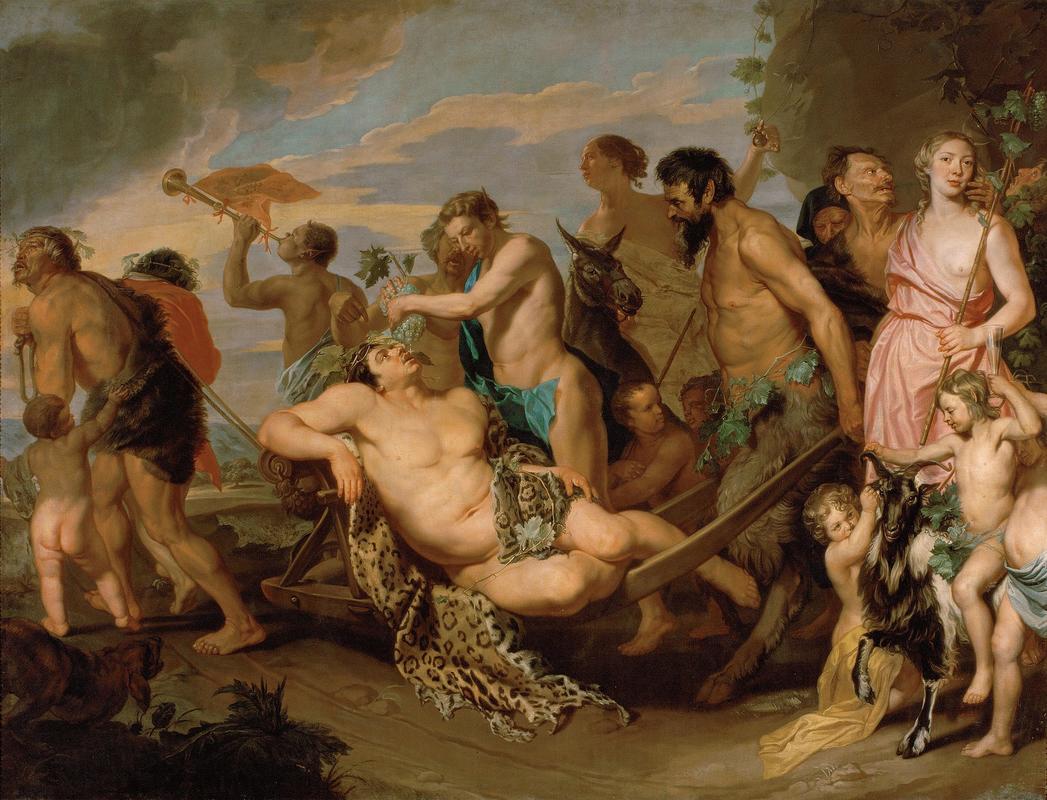More about The Triumph of Bacchus

Contributor
According to Michaelina Wautier scholar Katlijne Van der Stighelen, the greatest and most important work of the baroque master Wautier is her Triumph of Bacchus, an overlooked example of her genius, parallelled only by a few of the Old Masters.
"Old Master" never actually meant European white men, except in art history books. Of course, there were people playing the role who were not European men, like Hokusai, for example, and there were European men who did not act the part and who were denied access to the same canonical writings which slammed their gilded doors in the face of Wautier, Artemisia Gentileschi, and thousands of other artists whose personal identifications did not directly fit the bill.
In 1993, the Anthony Van Dyck scholar Stighelen happened to see the Triumph of Bacchus while attending a symposium at the Kunsthistorisches Museum in Vienna. Her original plan was to see a possible Van Dyck in a storage space when, Stighelen writes, "A curator led me down long corridors in which ‘second class’ Flemish paintings were stored. As I was leaving the stores, my eye fell upon a monumental piece I hadn’t seen before"–Triumph of Bacchus. Stighelen's subsequent attention to Wautier has made a permanent impact on the study of art history.
One of many reasons that the university system in the United States and Europe is so heavily focused on getting as wasted, sloshed, or sauced as possible is that it is directly based on the "symposium" tradition of the ancient Greeks, an alcohol-soaked, ethically loose, intellectual party tradition with an orthodox religious justification. Greek culture explicitly encouraged welcoming attitudes toward drinking and sexual behavior, which are shockingly inappropriate to most people today. This is because the ancient Greek religious and mythological system that features the naughty Bacchus is no longer as dominant as it was, due to the rise of Abrahamic faiths which consider the Greek and Roman faiths to be idol-worship.
The character of Bacchus, also known as Dionysus, the son of Zeus, was revitalized with a distinctly mischievous, cheeky glee by Friedrich Nietzsche and the French novelist Georges Bataille. More recently, a surprising and deep current of scholarship in gender and women's studies has looked at Bacchus with new eyes. One of the pastimes of Bacchus was encouraging women to throw off their social roles and clothes. A book on Nietzsche and feminism describes Dionysus as the deity of "intoxication, demented flowering, of dance, music...beyond speech, beyond cognition." Wautier's incorporation of herself as one of the Bacchae, the female followers of Dionysus commemorated in the tragedy by Euripides, exposing one of her breasts and looking directly at us, is way ahead of it's time. Yet again, it is an example of a woman birthing an idea in visual art that would be re-deployed, to great profit and fanfare, by a male artist much, much later, without any recognition of the female originator. In this case, I am referring to Edouard Manet's galvanizing work depicting nude women staring directly at the viewer.
The art world is finally beginning to acknowledge Wautier's contributions, though. "The recent interest in Wautier’s oeuvre comes from a sale at a Koller auction in Zurich in March 2016, in which her 1654 portrait of Jesuit missionary Martino Martini sold for CHF400,000 ($399,800) with an estimate of CHF7,000—CHF10,000." This 2016 Koller auction is truly Dionysian in it's excess, as the buyer spent around forty times the estimated value of the Wautier.
Sources
- Elbaor, Caroline. "Female Old Master Painter Gets Her First Big Show." ArtNet, Jan. 27, 2017, https://news.artnet.com/exhibitions/female-flemish-painter-first-exhibi….
- McCouat, Philip. "FORGOTTEN WOMEN ARTISTS #4 Michaelina Wautier: entering the limelight after 300 years." Journal of Art in Society, http://www.artinsociety.com/forgotten-women-artists-4-michaelina-wautie….
- McEwan, Olivia. "The Criminally Overlooked Talent of Baroque Painter Michaelina Wautier." Hyperallergic, Aug. 15, 2018, https://hyperallergic.com/455577/the-criminally-overlooked-talent-of-ba…
- Patton, Paul. Nietzsche, Feminism and Political Theory. New York, Routledge, 2002.
- da Silva, José. "Newly discovered Michaelina Wautier painting added to first major show on Baroque’s forgotten female master." The Art Newspaper, Jun. 20, 2018, https://www.theartnewspaper.com/news/new-discovery-by-baroque-s-forgott…
- Van der Stighelen, Katlijne. "‘Doing justice to an artist no one knows is quite an undertaking’." Apollo Magazine, Jul. 2, 2018, https://www.apollo-magazine.com/doing-justice-to-an-artist-no-one-knows….
Featured Content
Here is what Wikipedia says about Triumph of Bacchus (Wautier)
The Triumph of Bacchus is a painting by the Walloon artist Michaelina Wautier. It was painted between 1650 and 1656 and is one of Wautier's greatest works, as well as her largest. Based on classical texts, the picture shows a procession with the drunken god Bacchus at its centre, surrounded by other humans, satyrs, and animals. It is notable for its large number of nude male figures, something uncommon from a woman artist in this period.
It was possibly commissioned to be part of the large collection of art amassed by Archduke Leopold Willhelm; in any case by 1659 it was noted in an inventory of the collection.
It now hangs in the Kunsthistorisches Museum, Vienna.
Check out the full Wikipedia article about Triumph of Bacchus (Wautier)












